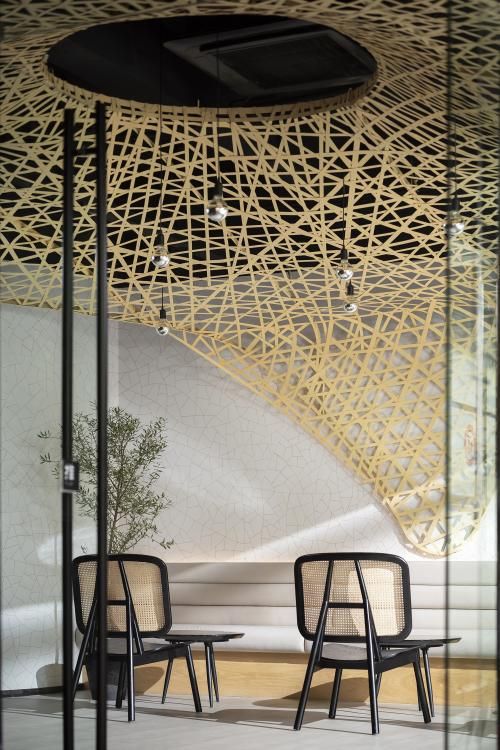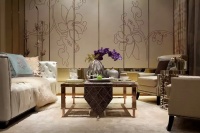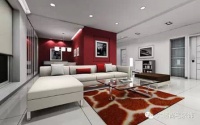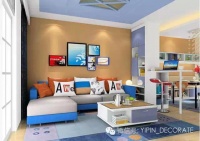高志强新作 | “浅在”茶室:品一室茶香
茶以幽香于无形之中入胃入心,让人们由内而外地清爽通畅。一个空间如何拥有这种能力,以润物于无声的方式,让进入的每个人在不知不觉中收获一份安宁。
The fragrance of tea is subtle, but people can easily get soaked up in it and feel refreshed from mind to body. How to apply such a quality to a space and allow its visitors to have a piece of tranquility unknowingly?
这是浅在茶室经营者的诉求,也是空间情绪践行者高志强的思考,“我觉得理想的、属于年轻人的茶的空间,应该是开放的,自由的,有艺术气息并富于当代感。”如高志强所说,营造一个非常现代的空间,赋予她东方气韵,对于一个理想的中国茶空间来说,可能是最好的呈现方式。
This is the question posed by the owner and to be answered by Steve Gao, the chief designer. As a practitioner of space emotions, Gao believes that the ideal tea space for young people should be open, free and easy, and possess an aesthetic and contemporary touch. As Gao puts it, the best possible way to present an ideal Chinese tearoom is to create a modern space and infuse it with eastern vibes.

浅在茶室所处的深圳华侨城创意产业园并不缺潮酷的元素,但如何让忙碌的年轻人们能够在这个空间中寻找到难得的放松宁静,却又不会过于厚重老气,则是摆在设计师面前的问题。事实上,在当下,中国年轻人对于审美和生活品质的追求已经开始从盲从、模仿,到能够独立笃定地跟随自我的喜好,而属于东方的雅致生活和茶文化的复兴也成为意料之中的新趋势。中国人饮茶的历史非常悠久,但饮茶方式需要根据当下的生活方式进行创新。
The complex in which TEA-Z sits never lacks trendy elements, the issue the designer has to deal with is allowing tea drinkers to have some quiet and relaxing time at TEA-Z without feeling they are out of style.
The truth is the younger generation in China are finding their own likes with great confidence when it comes to the pursuit of aesthetics and the quality of life rather than blindly chasing the fuss and mimicking.
The renaissance of an elegant eastern lifestyle and the tea culture becomes an expected new trend. The Chinese have enjoyed a long history of drinking tea, but the way of doing it requires some new thoughts to match the lifestyle these days.
整个空间被划分为四个区域,分别是前厅茗品区,吧台出品区,库房和消费展示区。小库房则在储物之外,对空间入口做了一个“收腰”的处理,让人感到一种先抑后扬的感受。
The space is divided into four parts, including a front lobby for having a taste of the tea, a bar counter, a storage room and a display area for purchasing. The storage room, apart from its basic function, is used to narrow the space in the middle part of the room, giving the customers a differentiated view as they walk through the tea house.
设计摒弃了传统方式,采用了一个手工编织的竹编艺术装置覆盖了整个空间的顶部并延伸到部分墙面,这个手工竹编艺术顶面的灵感来自于渔夫撒网似的自由形态。这个竹木色正好和空间中借鉴中国水墨画黑白灰三个色调形成了非常好的平衡。大面积的竹编装置也伴随着点茶、饮茶的整个过程,以蜿蜒流畅的线条在茶室中铺开。像是渔夫在海面上尽力抛出弧线,自然掉落在海水表面的轮廓,饱满、流畅,带着原始的拙朴质感。原木的色泽和竹的轻盈最大限度地实现了“渔网”的曲线、轻盈和自由感,在夕阳的光照之下有些渔舟唱晚的诗性与惬意。
Instead of the traditional way to decorate a tea house, an installation of multiple strips hand weaved in bamboo is used to cover the roof and to further extend to part of the walls. The design was inspired by the fluid movement of a fisherman who is casting the net.
The color of the bamboo strikes a perfect balance with the black, white and grey in the space, which are the colors often used in traditional Chinese brush painting. People can enjoy their tea and refreshments in this winding space while appreciating the installation.
The handmade craft reminds people of an image of a fisherman casting his net with full strength and the curve falls naturally on the surface of the water, solid and smooth, with a touch of rawness. The lightness in the tone of the material best speaks to the casual and unbridled curves, adding to the space some poetic and comforting elements.
此外,墙面上的浅色纹理是受中国陶瓷开片的启发,按 1:1 比例画出,再经过人工绘制到墙面上的。开片是中国陶瓷最常见的烧制手法,而陶瓷作为茶叶的容器,它的品类、工序、色彩与釉面又从一定程度上影响着茶叶冲泡出的香气和口感,作为茶文化必不可少的元素,与整个空间的内在精神暗合。
The light-colored textures on the wall drew its inspirations from the cracks in Chinese ceramics, the lines were drawn in the same proportion as the cracks and painted on the wall by hand.
Cracking is the most common method for firing Chinese ceramics, and as the container for tea, the categories, procedures, colors and glaze of a pottery always has an influence on the fragrance and the taste of tea. Therefore, the walls exist as an indispensable element in the room to match the design of the space.
茶室中选择了没有侵入感的弱照明,极大地削弱了强光的压迫感。针对每个区域,照明都是单独设计的,水滴形状的灯具,下半部是水银镀膜,让人们即便抬头直视也不会觉得刺眼,非常像雨滴洒落在空间中。见光不见灯的含蓄方式,让舒适的光线在空间中弥散开来,静谧的氛围也让步入其中的人们不自觉地轻声慢语,卸下焦虑。
Friendly soft lightings are used in the house to avoid the aggressiveness of harsh lights and they are designed separately for different areas. The lamps that resemble a drop of water are covered in mercury coatings so that people do not get glaring stares even when they look the lamps directly, and they are like raindrops falling into the space.
The room is immersed in the pleasant lights coming from the thoughtfully placed lamps, and people entering into the space begin to speak in a softer tone and unload their anxieties without even noticing it.
茶室没有任何阻挡和隔断,在座位的排布上更像是一个开放通透的咖啡厅,这也是设计师有意为之。“我们希望人和人之间是相互看得见的,它应当是一个开放的社交场所。”如高志强所说,空间当中这个连绵的曲线装饰,也以温柔的方式完全打破了不同区域的界限,将顶部、墙面连成片,营造出完全开放的氛围。
There are no interferences or blocks in the room and the arrangement of seats reminds people of a spacious café, which is an intentional move by the designer. “We hope that customers are able see each other and this tea house should be a place for people to connect,” Gao said. The curving bamboo installation makes the space boundaryless and forms a link between the roof and the walls, creating an open and free atmosphere.
通过色彩、材质、照明和声音设计,最终营造出属于一个空间的特定情绪,也是高志强一直以来践行的设计理论。浅在茶室的黑白灰和木色组合,弱照明,以及空间中悄然流淌的自然元素,搭建出浅在独有的气质 —— 自由、静谧、从容、开放。这也恰好是业主希望赋予这个新型茶空间的内核,希望每个走入浅在的人都能拥有的心境,而设计师也借由这个案例再次证明了空间情绪理论对于室内设计在心理层面上的影响力。
The design creates a specific emotion for the space through the use of colors, materials, lightings and sounds, it is a philosophy that Gao has been practicing along the way. The color combination, the soft lightings and the fluidity in the space brings a unique temperament to TEA-Z that is unconstrained, quiet, unhurried and open.
This is what the owner has hoped for this new type of tea house and for how the visitors feel when they walk into the shop. Gao, as the chief designer, has proved once again the psychological influence the theory of space emotions has upon interior designs.
工作之外,高志强也习惯泡一壶茶伴随一天的工作和生活。“我也喝咖啡,但是茶是我全天在喝的一个饮品。” 他说,“很多人只是没有找到合适自己的那款茶,一旦遇到,你永远都离不开了。” 高志强说,咖啡和奶茶喝多了会心慌、会腻,但茶是不同的,它清淡却长久。真正的茶也不需要添加任何辅料,因为茶自身的魅力已经足够让人陶醉。
Gao also has the habit of drinking tea while he is working or at his leisure time. “I drink coffee, but tea is my all-day drink, “Gao said. “For those who do not like tea, it is probably because they have yet found the tea for them. Once they found it, it will last.” Unlike coffee and milk tea, which often lead to over stimulation and excessiveness in taste, tea comes with a light but lasting flavor. A glass of quality tea needs no other ingredients and additives as the tea itself is good enough to charm the people who drink it.
项目平面图
Plan for the project
项目名称 :浅在 TEA-Z
Name: TEA-Z
项目地址:深圳
Location: Shenzhen
设计公司:AFFD设计事务所 www.affd.net
Agency: AFFD Design www.affd.net
主创建筑师:高志强
Chief Designer: Steve Gao (GAO Zhiqiang)
辅助设计师:李瑞瑞、陈德利、彭兴益、陈浩
Assistant Designers: LI Ruirui, CHEN Deli, PENG Xingyi, CHEN Hao
设计面积:210 平米
Design Area: 210m2
项目完工时间:2020年07月
Time of Completion: July, 2020
摄影师:史云峰
Photographer: SHI Yunfeng
施工单位:深圳市湛艺建设集团有限公司
Construction Company: Zhanyi Decoration Group
相关知识
高志强新作 | “浅在”茶室:品一室茶香
酷+创造营招募 | 高志强+李益中带队 探索深圳网红茶馆与办公空间设计
约三两好友,在茶韵中式客厅静享幽室茶香
汇客廳茶室| 如何泡得一壶好茶?
一间茶室,打造家的茶味空间
茶室 | 最美还是新中式!
来学学怎么布置一个高端大气的茶室
茶室养成的三要素
风景独好的开放式阳台茶室,让品茶时刻无比舒适....
一间茶室,竟然是很多人挤破脑袋也要打造一个迷你茶室!






